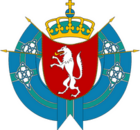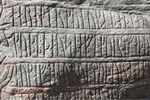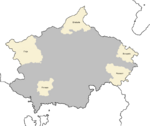History of Blechingia
The History of Blechingia can be traced back to the melting of the Southern Polar Ice Caps. From as early as 12,000 BC, humans have inhabited this area. Throughout the Stone Age, between 8,000 BC and 6,000 BC, early inhabitants used stone-crafting methods to make tools and weapons for hunting, gathering and fishing as means of survival.
Written sources about Blechingia before 1,000 AD are very rare but aren't uncommon. If they are about the inhabitants of the land its normal short and most likely written by there northern neigbors. Most of Blechingia's written history by her own people isn't really record until about the 1270's to between the 1360's. Meaning the first real Blechingian event to be record by Blechingian writers is the War of the Linnaea borealis. But depending on the region written records started earlier but most histoirans argree that the overall prehistory of Blechingia ends sometime in the 13th century. With History staring after that point.
The modern Blechingian state was formed over a long period of unification, consolidation and civil war. So must historians agree that the true modern day state of Blechingia is formed after the 3rd Gothic Civil War to of which after this point the history of Blechingia turns away from war and more towards the every day factors of the government. With Blechingia focues away from consent inter struggle for power Blechingia was know able to focues on more international affiars like the Aleman Colony War of Indepence which would create a 250 year hated for the country of Krenya. And also the as Blechingia add the colony of Aleman.
Part of a series on the |
|---|
| History of Blechingia |
 |
| Timeline |
Prehistoric Blechingia before AD 800
Stone Age (12,000 BC to 1,700 BC)
The eviendce of humans starts around 12,000 BC with there arrive into Blechingia.
Blechingia has a large number of petroglyph (Steinsteypa in Götaish), with the highest concentration in the province of Shannon. What was probolly people from the Finja culture sometimes refer to as the northern River Shannon culture but the name isn't widly used by the acacimic commonntiy
Bronze Age (1,700 BC to 500 BC)
The largest and earlist brozen age battle happened around the year 1,320 BC in what is today the Isealchríche Valley which is part of the Áine River. Which is located on the West Goutian Plain aka (The Shannon Plain). The site was discovered in 1983 by Geologist Ían Konráðsson. At the time it was no widly known for what the site was some thought it was probally a mass burail site. others thought the size of the site was way to big. It remind a mistory until 2002. When Ían Konráðsson and some other scientist where granted permisson to dig in the site for only 98 hrs by the Blechingian Gov't
Iron Age (500 BC to 800 AD)
Iron Age Blechingia often called the Nordgælic Iron Age in Blechingia was a period of time in which cilivation in the region started to form into more well developed kingdoms and tribal nations. Between 2000 BC to about 970 the nordic and gaelic peoples that shared the land would often fight one another as the main force behind it was differnce of religion as on was a celtic pagaism and the other a germanic the two groups would never understand eachs others beliefs. Around 620 AD christians from the west started moving in the River Shannon area home to most of the gaelic's people. They would become the first to convint to christianty abd because of this they would start to record there history and there other tribes that at time still don't write down there history.
Middle Ages
Early Middle Ages (800 AD to 1000 AD)
With the start of the early middle ages came along with the rise in Kingdoms most important the rise of the Gothic or geats kingdoms along the south central coast line of what is of what is the moderon border of Blechingia. The peoples from these kingdoms really didn't leave much written record of there exits because some runes that have almost been found in region of Blechingia the one region that had somewhat of a written record is mostly along the present day border of Medovia a but most historians don't accept these writtings as pure Blechingian as they probally where created somewhere in Medovia.
Plague and Famine
From about 1340 lasting until around 1650 Blechingia would have to deal with waves of famine and disease. The most famous being the Heratic Plague, you can read more about that below.
Heratic Plague
The plague spread through East Blekinge, starting in hamlets, villages, farms and towns. It is still not clear on how it started but once getting to larger cities it would spread like fire. killing at the time what is to
The most affected by the plague where manly large trading cities located in the eastern have of the nation. Malmö being the regional power was dismated by the plauge most schocalers believe up to 2/3rd of the population got the disease but est. range from a few 1000 all the way to 26,000.
It is reported that of the 200,000 known citizens of what was the western half of East Blekinge that is know as Aleman had a total population of 98,879 in 1412 a 51% drop in population. Causing great civil unrest in the region. But the area not affected at first was Blekinge, until around 1427 when it made it self at home in the nations capital of Göteborg.
Pesants Revolt
Famine of the 1450's
The famine of the 1450's sometimes called the (Great Famine of 1450), was a large scale famine that took place during the end of the mediveal warm period that ended around 1455 AD. With the end of the warm period came periods of harish and hostable growing seasons for crops leading to a shortage of food. The famine would hit the West Gothian Plain the hardest as at the time most people lived in the areas flat and somewhat fertal soil
The Dark Republic Era
The "Dark Republic Era" (Dökk lýðveldistímabil in Götaish), was a time of extreme violence that lasted from the start of the 1st Gothic Civil War in 1470 and ending in 1502 after the 2nd Gothic Civil War in which Magnus retakes his sister crown. The dates of the "DRE" are strongly agreed a pound. As before 1465 there was really no panic in the house of jarls over the monarchs handing of the nation. Even today most historians can't agree why some far outsider Jarls would take the change or more widely known a political suicide.
The Dark Republic era starts with the 1st Gothic Civil War with King Magnus V having ruled for 40 yrs by the start of the war. The kings supports are called the "Royalist" as they are the ones that back the current King and government. The "Republicans" lead by leader Charles Johansson are a group of far out jarls that wish to bring down the monarchy. The civil war starts the "Royalist" winning most of the battles but by 1475 it starts to turn againest the king and his supports and the "Republicans" where taking large parts of there kingdom. By 1478 the king was heath was becoming worse by the day. And on the morning of 1 September 1479, King Magnus V of Blekinge die's sometime during his sleep. Over the next couple hours Prince Magnus is sent for as he well be the King of Blekinge. But the Prince has a much different plan and that was and also what happened was he refused the crown and title of King, instead giving it to his little (and only 100% biological) sister Christina I. Christina was only 19 years old when becoming Queen of Blekinge. After becoming queen she quickly focased on the issuse at hand the bloodly civil war. From late 1479 until early 1481 the queen's forces gained much of the land lost when her father was become quit ill. But her success where not to last long as by Spring of 1481 the "Reps" called by the royalist for short where gaining on the capital. By summer they had the capital surronded on all sides land and sea. With the capital of Göteborg surround the only opion was to escape the city by tunnel and head towards friendly Medovia. But unforsgal they are seen and arrested. Christina would spend the remind of her life in a Republican prison. And also being physical wiped and other things as written by personal biographer. Christina would be executed 11 January 1486 at the age of 25. Most belivie she was probally hanged and not behead as most "Reps" saw her a a victum of the monarchy but some wished other means of death for the former queen of Blekinge. After her death the "Republicans" would radickly change the nation but soon most supporters of the "Reps" where know focaced on getting rich of the monarchys emergy money estimates believe there was probally $1.2 million in todays money. The superintendent as what Chrales Johansson would go by his regin as leader wasn't to bad for tje average blekish citizen but for the royal family and upper class citizens ot was a nightmare. With the execution of the last queen Christina most of her family would feil for friend nations around them. But some would never make it as the rebs would once in a will recive a tip of who and where they planning on escaping. The next superintendent August Charlesson was by for the weast for tje people as he would single handly distory the ecomony of blekinge almost staring a civil war before dieing of unknown c
Early Modern Blechingia
Krenyan Colonial History (1583- 1870)
On 5 August 1583, Sir Humphrey Cerian claimed Etain as Krenya's first overseas colony under Royal Charter of Duke Alfred of Krenya, thus officially establishing a forerunner to the much later Krenyan Empire. Etain is considered Krenya's oldest colony. At the time of English settlement, the modern day Blechingians inhabited the island.
The Krenyan immigrants, mostly selenzians built a society in the island unlike the ones they had been present there.
Etain was in contact with many ports and societies around the laventine rim.
But its geographic location and political distinctiveness isolated it from its closest neighbours, the Kingdom of Blechingia. Internally, most of its population was spread widely around a rugged coastline in small outport settlements.
Many were distant from larger centres of population and isolated for long periods by winter ice or bad weather. These conditions had an effect on the cultures of the immigrants.
They generated new ways of thinking and acting.
Etain developed a wide variety of distinctive customs, beliefs, stories, songs and dialects.
As time passed the krenyan population in etain increased and so did their interactions with the blechingians, as could be seen by the krenyans getting trade approval from the Blechingian monarchy in 1596 AD,
After a couple of years of trade with the blechingians, the krenyans were actually in a better position with their colony i.e etain actually being the richest fiefdom of krenya at that time.
As time passed krenyan interest in mainland blechingia and lyonheimer i.e then called east blekinge grew and krenyan trade cities were constructed with the permission of the monarch of east blekinge.
The krenyans aided the Royalist factions in the civil wars of 1660's in a deal, that made the monarchy give up their capital malmo to the krenyan colonial administration and later when the royalists won the krenyans got what they wanted. After some time, in the 1710's, the krenyan colonial administration signed a treaty with the blechingian monarchy which effectively made them a krenyan colonial administered territory, in exchange of that, the house would be protected by the krenyans during any internal revolts.
The population of blechingia however wasnt that much fortunate, the Duke had orders to use the population as slaves to work in the fields of the nobles who ruled blechingia, de jure and also to do manual labour, with slavery only being abolished after the thismari revolutionary war.
In the 1800's, the Blechingians protested against the Krenyan Rule as they were given little to no priority and all of their produces were being shipped back to Krenya via shipping,
So in late 1790's, A Military leader named Francis Beaufort launched a series of attacks against the governmemt of Krenya, and as a result Krenya concentrated on quelling the Rebellion even more,
The Kingdom of Blechingia was payed and Heavily propped up by the Krenyan Regime to fight and eliminate the military general, and later the military dictator, who would be eventually defeated in 1820's and would later be executed by the Krenyan Royal Armed forces a few months later.
Following the Rebellion, the Colonial Government prioritised the expansion of infrastructure in the eastern parts of Blechingia, then known as Aleman, and began to build ports connecting the island of Etain to Aleman in the following years.
After some time, in the 1710's, the krenyan colonial administration signed a treaty with the blechingian monarchy which effectively made them a krenyan colonial administered territory, in exchange of that, the house would be protected by the krenyans during any internal revolts.
The population of blechingia however wasnt that much fortunate, the Duke had orders to use the population as slaves to work in the fields of the nobles who ruled blechingia, de jure and also to do manual labour, with slavery only being abolished after the thismari revolutionary war.
In the 1800's, the Blechingians protested against the Krenyan Rule as they were given little to no priority and all of their produces were being shipped back to Krenya via shipping,
So in late 1790's, A Military leader named Francis Beaufort launched a series of attacks against the governmemt of Krenya, and as a result Krenya concentrated on quelling the Rebellion even more,
The Kingdom of Blechingia was payed and Heavily propped up by the Krenyan Regime to fight and eliminate the military general, and later the military dictator, who would be eventually defeated in 1820's and would later be executed by the Krenyan Royal Armed forces a few months later.
Following the Rebellion, the Colonial Government prioritised the expansion of infrastructure in the eastern parts of Blechingia, then known as Aleman, and began to build ports connecting the island of Etain to Aleman in the following years.
In the 1880's, due to decades of unrest following the Thrismari revolution, The Colonial government of East blekinge began to experience several riots in the western parts of Blechingia, with the largest of them occuring in malmo in 1887, unable to hold on to western blechingia, the Colonial Government granted Blechingia its independence in 1890 AD.
The Krenyans heavily industrialised Aleman in the following decades, with Malmo being one of the most busiest cities of Colonial Krenya at that time, Krenya also made several factories all across aleman with some of them still being active today, most of them being used to refine metals and to make quality consumer goods for the Krenyan population Present in Aleman in the 1900's.
In 1907, Krenya went to war with The Alliance one of the two alliances of the Great war and forced Alemanish people to Join the army in return for economic benifits and better standards of living, which many of them agreed to, however Blechingia took the advantage of krenya being in a two front war in the mainland and declared war on krenya, which immediately led to the lyonheimer participation in that conflict, the war lasted for 5 years and finally in 1911, after krenya signed an armistance with the alliance, the Colony of aleman was finally integrated with Blechingia, in 1912 AD.
Era of Rebellions
With the end of the 18th century coming to a close a group of leaders meet in secert on the 08 May 1799 to form a new nation New Blekinga seperating itself from the Kingdom of Blechingia to of which by
East Blenkinge
East Blenkinge is the territory of the moderon nation of Lyonheimer. Some people would classify anything east of the River McKenna as eastern Blekinge but the term east Blenkinge refers to Lyonheimer or any land east of the .... mountains.
Colonies and slavery
Blechingia would never become a colonial empire based on the fact that they saw first hand what Colonial empires care about. Blechingia was as a major slave nation until the 1690's. But most of Blechingia's slaves where what we call today pow aka prisoner of war. They would mostly be given freedom after 5 years and never move back to the old nation or region they where from when the war started.
Moderon Blechingia
Late 19th Century
20th Century
Blechingia was involed in the globe war know as the Great War. A rebellion occurs on the island of Étaín, a Krenyan controlled Blechingian Island, in 1907. Krenya would have to spend much more time defending Étaín as without it make getting reinforcements to Aleman much harder. Krenya decided to telegram their occupied territory, Lyonheimer-Krenya Empire, who they asked to aid them in stopping the rebellion. They successfully halted the rebellion, however it caused tension with Blechingia, who was neighbours of the Krenyan-Lyonheimer Empire. This began a 5 year conflict (1907-1911) on the Southern Front. This conflict was fought in trenches and was mostly stailmates. With brutal snowy conditions, due to the Lübbenau Mountains, the conflict was hard on soldiers from both ends.
Great War
New Kingdom
With the end of the Century Blehingia would once again change. In the late 1890's Blechingian's had grown tried pf being ruled by a foreign power. On 08 March 1896, 78 Jarls from all over the nation signed a piece of paper stating their wish for an indepent Blechingia again ruled by the rightful person the Blechingian Monarchy, Which my this point had helped in more ways then one get Blechingia to a state of indepence.
New Union Created
On 20 February 1998, Blechingia and its eastern neigbor created the TU. As a way to bring nations locted on the contiomant closer
21st Century
With the start of the year 2000 AD the nation of Blechingia had been conflict free for a century.
As of January 2021 Blechingia has only had two monarchs as king and queen. Ivan III from October 1995 until his death in October 2017. And his youngest daughter Emily II from October 2017 till the present. Emily is also the youngest queen and first queen since here 3rd great-grandmother Margerat I of Blechingia. Emily has enjoyed a peaceful start to her regin. She has maded it her goal for her regin to make relations between Blechingia and Krenya better then when she became queen in October of 2017. In January 2021, the queen's cousin Princess Helga Andersdottír, became the first person of Blechingian Royal blood to marry a Duke from Krenya. The news was received well across most of Blechingia, a few are still a little scemtic about the Duke. In May 2021 the Queen anncoed that she was in a relationship with Maricoen Prince Walter.


